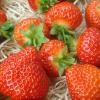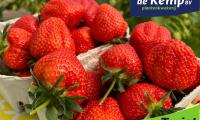...
Salsa
Productivity:
5
Taste:
2
Earliness:
1
Disease resistance:
4
Shelf life:
3
Firmness:
2
Salsa, a rich experience of flavour and fullness. Salsa is a late June bearer that comes into production about one week after Sonata. Strong properties are its good flavour, in combination with late harvest, very good yield and very large, orange-red fruits. Additionally, Salsa is minimally sensitive to mildew and wilt. This makes the variety useful in areas not suitable for many other varieties. Salsa is grown successfully in open field cultivation in central and northern European countries where the focus is on companies with direct sales.
Properties of Salsa
• Very large fruit
• Late and flavourful
• Highly productive
• Frost resistant
• Verticillium-tolerant
lossoming and harvest period
Salsa makes a robust plant that blooms rather late. Because Salsa also blooms under the foliage, there is less chance of damage from late frost. The quality of the flowers is very good. The flowers, which are very big like the fruit, produce more than enough pollen. The harvest of Salsa is about 1 week after that of Sonata.
Fruit quality
Salsa produces very large, conical, orange-red fruit with an often slightly upright calyx. The strawberries are glossy, have somewhat sunken seeds and often a white collar. As a result of exuberant growth, the first fruits can develop into very large, slightly grooved fruits. This always makes the fruits remarkable and easy to recognize. The average fruit weight is usually between 25 and 30 grams. The strawberries are juicy and have an excellent flavour in comparison with other late varieties. The fruits are easy to pick. However, this must be done carefully to prevent brushing.
Productivity
Salsa is very productive and gives a yield well above that of Sonata and comparable to that of Florence. Because of the large fruit size and the fact that the fruits are easy to find and to break off, the picking performance is generally good. They are also very easy to sort.
Susceptibility to disease
Salsa produces very robust plants, which unlike plants of many other varieties are hardly susceptible to wilt (Verticillium dahliae). Salsa plants also have little trouble with powdery mildew (Sphaerotheca macularis) and crown rot (Phytophthora cactorum). Salsa is, however, sensitive to fruit rot (Botrytis cinerea). Therefore, preventive spraying against fruit rot during flowering is very important, partly because Salsa can develop a relatively dense plant.
Growing experience
In normal cultivation and cultivation with cold-store plants, Salsa develops a heavy to very heavy crop. Therefore, a planting density of 40 to 45 cm is often recommended. After a sluggish start, the bunches emerge from the plant well and are clearly visible. The plants also often tend to produce runners, and this requires the necessary attention during cultivation. Apart from that, Salsa is a variety that can be cultivated fairly well with standard fertilization. However, care should be taken regarding the quantities of nitrogen and phosphorus. If it receives too much fertilizer, Salsa will develop an excessively heavy crop. This can result in problems with fruit rot and also may decrease the firmness of the strawberries. When covered with straw, the harvest of Salsa will be delayed for 7 to 10 days. This will cause some reduction in production and fruit size, but this reduction is less strong in Salsa than in Florence.
Salsa does well in somewhat colder growing regions and northern and central Europe. There, experience has shown that the variety is not very sensitive to disease and frost in winter. Due to the late flowering, however, extra attention should be paid to the control of the strawberry blossom weevil (Anthonomus rubi). The variety is well suited for a perennial crop, especially since both yield and fruit weight remain good in later years. Salsa is also a good option for cultivation in older soil, where strawberries have already been grown for many years and soil sterilisation is not possible. Because of the vulnerability of strawberries, Salsa is grown mainly at companies that have short distribution lines for the fruit and at “pick your own” farms. The large fruits are often an eye-catcher there.
For more information take a look at the flyer
Rijptijd tijdsbalk:








